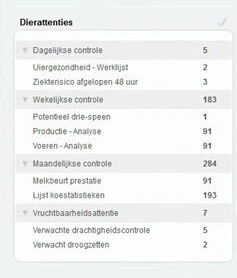Heifers learn to visit the VMS faster.
Another handy tip from a technician.
We regularly discuss here how important it is for newly lactating cows, and especially heifers, to learn to visit the VMS independently quickly after calving.
Because we can now divide lactation into five periods in the Automatic Milk Permission, it’s also possible to use the first period for newly calved heifers, for example, the first 20 days after calving. Use the same setting as the second period (from 5 hours and/or 7-9 kg expected milk yield), but let them enter the red zone after just 8 hours. For 2+ lactations, if there are no real problems, this would only be necessary for the first 10 days.
This way, newly calved animals are immediately identified if they need more time to learn or if they are experiencing other issues.
The sooner after calving you exceed 3 milkings per day, the better the lactation and udder health!!







